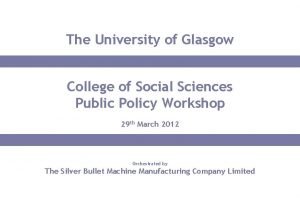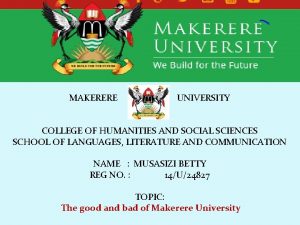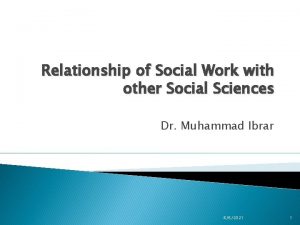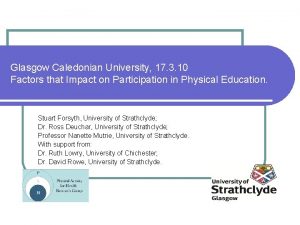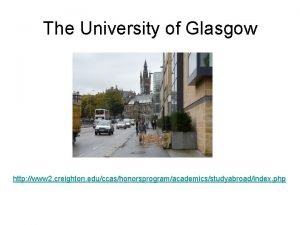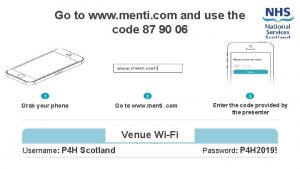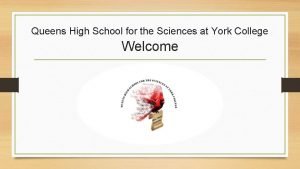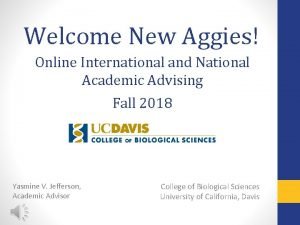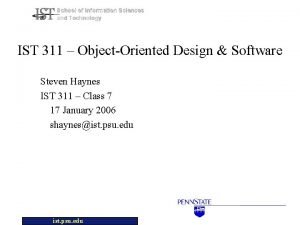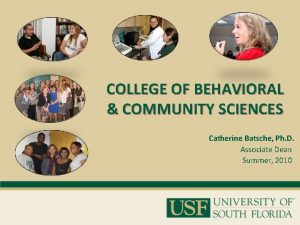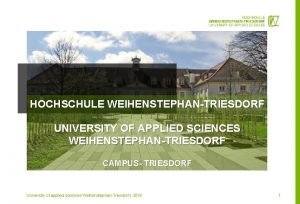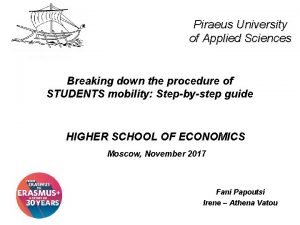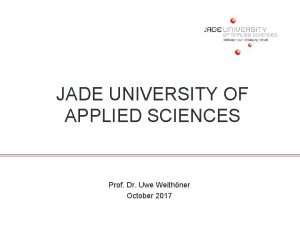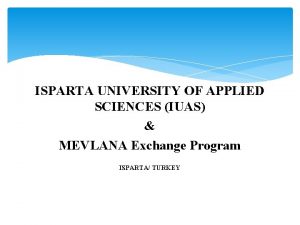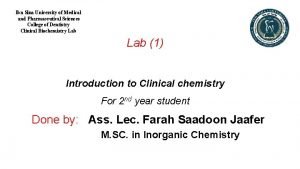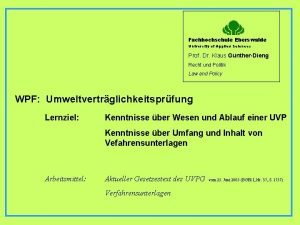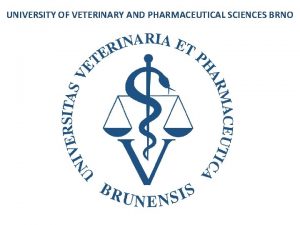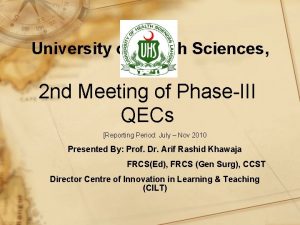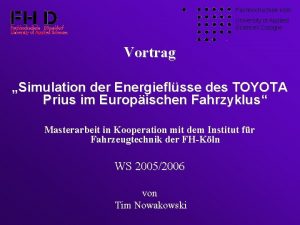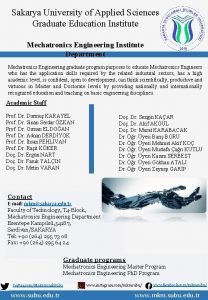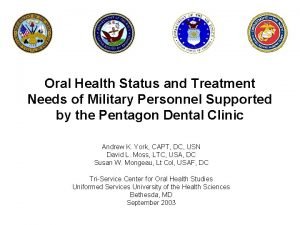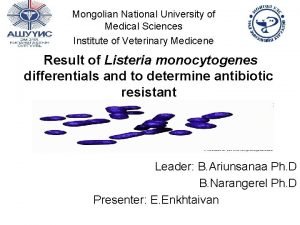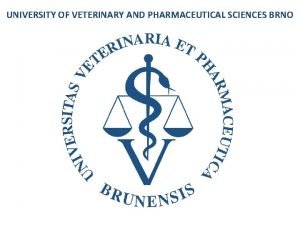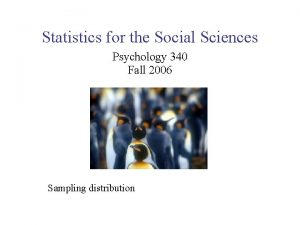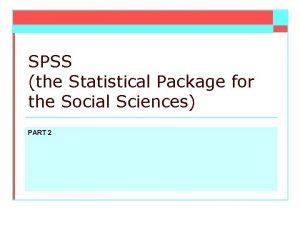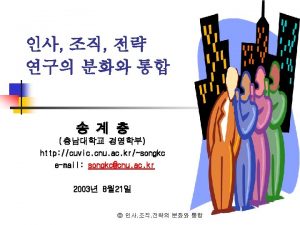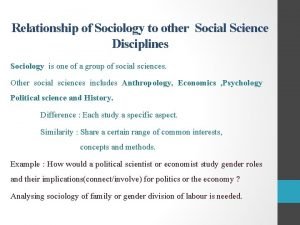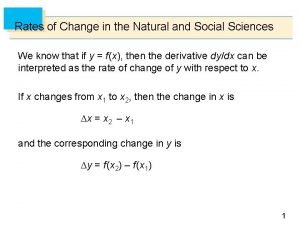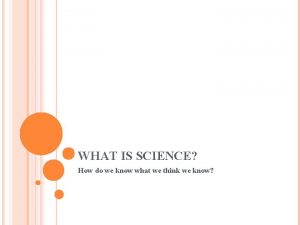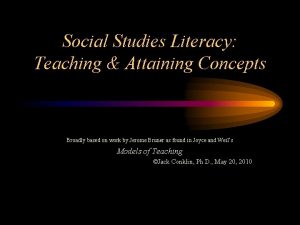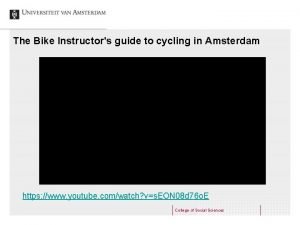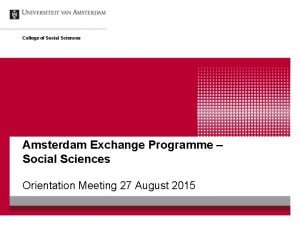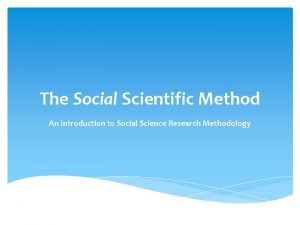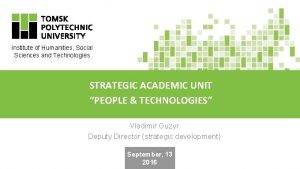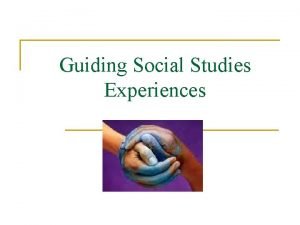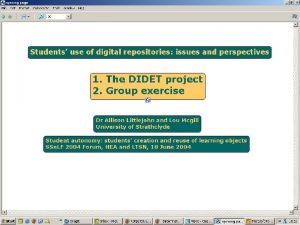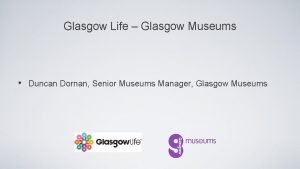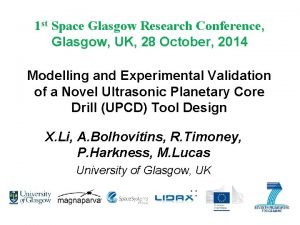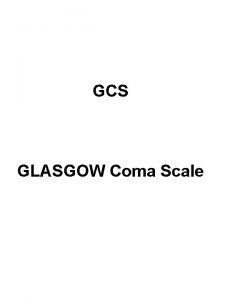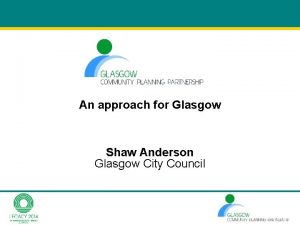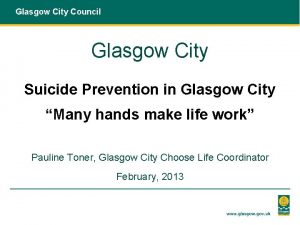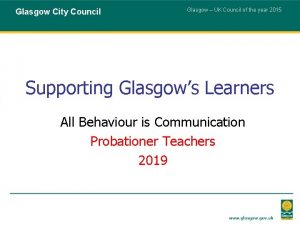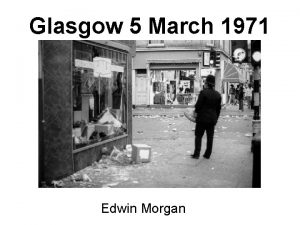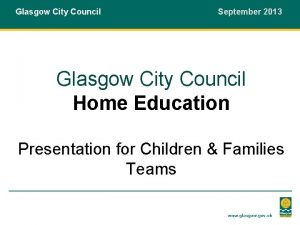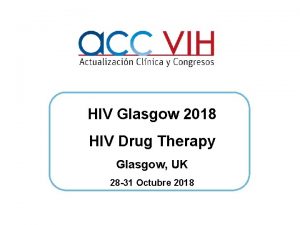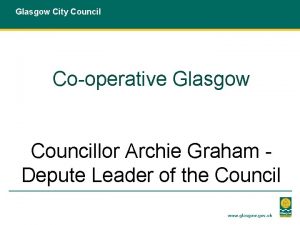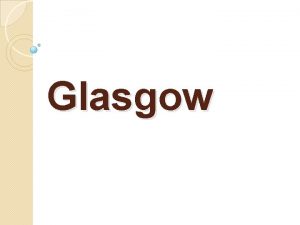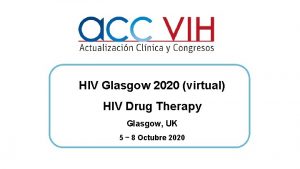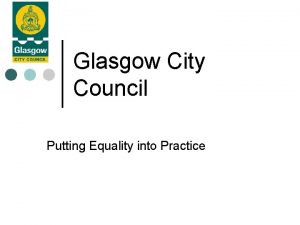The University of Glasgow College of Social Sciences
























































- Slides: 56

The University of Glasgow College of Social Sciences Public Policy Workshop 29 th March 2012 Orchestrated by The Silver Bullet Machine Manufacturing Company Limited

Silver Bullet

Contents Setting the scene 1 What, precisely, is ‘public policy’? 7 What, precisely, does ‘it’ look like? 13 The bequest 21 Impact 29 Branding 35 Beware elephants! 41 And finally… 47 Silver Bullet

Silver Bullet

Setting the scene 1 Silver Bullet

The team Andrew Hoskins Lyndal Bond Andy Furlong Mhairi Mackenzie Anne Anderson Michele Burman Catherine Schenk Ramona Fotiade Denis Fischbacher-Smith Gillian Doyle Simon Ball Fraser Rowan Iain Docherty Tom Mullen Sir John Elvidge Keith Kintrea Kenneth Gibb Dennis Sherwood of Silver Bullet orchestrated the event Silver Bullet 2

Workshop objective Within our University in general, and the College of Social Sciences in particular, we have very strong capabilities, and highly influential voices, in many aspects of public policy: our faculty includes many distinguished individuals, and we host some notable centres of excellence such as the Scottish Centre for Crime and Justice Research, the Centre for Cultural Policy Research, and the Institute of Health and Well-being, to name just three. That’s great. But is it possible to be even greater? Are there some important aspects of public policy that we don’t cover? Given that public policy is inherently broad, and joined-up, is our coverage broad enough, and sufficiently well joined-up? That last point, for example, is pertinent: academic institutions, and the academics within them, can live in ‘silos’ quite safely and indeed successfully – but might the presence of silos cause us to miss opportunities whereby our ‘whole’ can become ‘greater than the sum of our parts’? Might some form of ‘Public Policy Unit’ provide a vehicle to enrich our reputation, and enhance our impact and influence? To explore these questions, Anne Anderson convened a one-day workshop, attended by faculty with a particular interest in public policy drawn from the College of Social Sciences and the College of Arts, and also a highly wellinformed guest, Sir John Elvidge, who served as Permanent Secretary to the Scottish Government between 2003 and 2010. At the workshop, participants worked in small teams to ‘solve’ some carefully-drafted ‘problems’, each designed to explore different aspects of public policy, and to encourage new ideas: § § § “What, precisely, is ‘Public Policy’? ” (pages 7 to 11) “What, precisely, does ‘it’ look like? ” (pages 13 to 20) “The bequest” (pages 21 to 27) “Impact” (pages 29 to 34) “Branding” (pages 35 to 40) “Beware elephants!” (pages 41 to 45). This document captures the key results of a most invigorating, productive, and creative day; a day which generated many ideas, built much enthusiasm, and forged a strong, committed platform for making something real, and powerful, happen. 3 Silver Bullet

The benefits of a ‘Public Policy Unit’ To set a mood of constructive optimism, the workshop opened by inviting participants to identify the key benefits that would arise from the presence of some form of ‘Public Policy Unit’. Different people, of course, will have different ‘mental models’ of what a ‘Public Policy Unit’ might be – on a spectrum from nothing more than a brass plate on a wall to an edifice that would surpass Harvard’s Kennedy School. But in answering the question “what are the benefits? ”, the form doesn’t matter; furthermore, even if an individual thinks that the idea of a ‘Public Policy Unit’ is, overall, a bad one, that doesn’t stop there being at least some benefits… People Profile and visibility § § § § Raises our profile… …both academically… …and amongst policy actors. Raises the profile, and prestige, of ‘policy’ work… …and positions policy in the foreground of research. Increases our influence… …and impact. Boosts our civic role. ‘The Glasgow School’… …with a distinctive world-view… …could become the ‘go to’ place… …for policy actors… …as well as academics. Provides a gateway for policy actors to us. Silver Bullet § Being associated with ‘The Glasgow School’ enhances an individual’s academic prestige… § …and career prospects. § The unit will act as a ‘magnet for the best talent’… § …so fuelling a powerful virtuous circle… § …in which work of the highest quality attracts good people… § …who do work of the highest quality… § It will reduce my personal workload! The Scottish dimension § Provides a focus for Scotland. § Enables Scottish academics to become involved – and respected – on the international stage. § Provides a challenge to Edinburgh-centricity. 4

Some more benefits of a ‘Public Policy Unit’ Funding What it can do § More resources available to support outward-facing ‘impact’ work. § A ‘policy unit’ could investigate issues the government might (deliberately? ) choose to ignore. § We can – really – make a difference. § It will facilitate our work as regards its impact on policy. § Enables us to contribute to increasing the public good. § Makes us a distinctive centre not only for policy research, but also for policy innovation. § Will open new opportunities for funding. § Our enhanced reputation is likely to make it easier to receive funding in general… § …and also for more ‘risky’ or ‘different’ projects (“if this is something that The Glasgow School thinks is a good idea, it probably is…”). Content and process § § § § Provides breadth… …depth… …critical mass… …and ambitious scale. Ensures ‘joined-up-ness’. Promotes inter-disciplinary collaboration and integration. Enables us to escape from existing disciplinary boundaries. Enriches the range and scope of our methodologies…. …as well as providing an environment for the development of new methodologies. Ensures sharing of resources, such as quantitative expertise. Ensures sharing of knowledge… …and intelligence. Encourages sharing of networks. Will help make policy sense of research that is policy-relevant. A focus on policy formulation, design and implementation will help academic research to become more relevant and practical. Will provide a critical focus on the relationship between funding and policy, whilst maintaining academic independence. 5 Silver Bullet

Silver Bullet 6

What, precisely, is ‘Public Policy’? Andy, Anne, Keith, Lyndal and Ramona 7 Silver Bullet

What, precisely, is ‘Public Policy’? ‘Public Policy’ is a very wide field, so… Individually and in silence, make some notes on… Ø …as many different, distinct areas, topics, themes… that you can think of which you consider fall within ‘public policy’… Ø …how they might be structured or related… Ø …how these themes map onto academic disciplines. When everyone has finished, share your individual thoughts with each other. As a result, construct a comprehensive ‘taxonomy’, using whatever representational method you feel appropriate (lists, Venn diagrams, mind-maps…). Looking at our current capacities and capabilities… Ø Ø Ø Where are we relatively strong? And relatively weak? To what extent are the areas of relative weakness (if any) a ‘problem’? If they are not a ‘problem’, is it OK to ignore them? If they are a ‘problem’, what needs to be done to fix things? What are the benefits of doing so? How urgent is this? Overall, what are the implications as regards a possible new Public Policy Unit? Silver Bullet 8

What, precisely, is ‘Public Policy’? “That’s obvious!” is not at unreasonable answer. But maybe it isn’t quite as obvious as it might appear… and maybe different people have different ideas about where the boundaries are, about what’s in, and what’s out. This exercise therefore provides an opportunity to think this through, to suggest a ‘taxonomy’ which could serve as a basis for discussion and agreement, so forming a firm foundation for a possible new Public Policy Unit. An initial draft a taxonomy is shown on page 10, along with a rough (!) assessment of our current strengths: as can be seen, and indeed as we know well, we are already very expert in many areas. That said, the discussion triggered some important issues: § ‘Public policy’ encompasses very many individual academic disciplines, both obviously (law, sociology), and also less obviously (‘security’, for example, raises matters concerning surveillance, which depends on devices designed by engineers, using principles developed by physicists, and maybe deploying materials invented by chemists, within an ethical framework influenced by philosophers…). § ‘Public policy’ is inherently ‘joined-up’ – the item ‘security’, for example, appears under Crime and Justice and also Foreign policy; ‘jobs’ appears under Welfare and The economy. § Perhaps the most interesting feature of the diagram on page 10 is not what’s on it, but what’s missing. What are the areas of Public Policy that we haven’t identified, areas that might make a significant, and beneficial, difference to our potential capability? Areas that are missing are most likely to represent activities that we’re not engaged in now – but maybe we should be… 9 Silver Bullet

A taxonomy of ‘Public Policy’ …and what about… § § § § Silver Bullet 10 Policy making Policy design Policy evaluation Policy challenge Policy delivery Policy communication Policy implementation Innovation and new media Organisations Governance + Devolution + Internationalisation …?

A ‘Public Policy Unit’ – some ideas What a Public Policy Unit might do § Knowledge exchange. § Linkage across research areas. § Comparative analysis Ø local community Ø regional Ø national Ø continental Ø global. § Drawing out policy implications from research. § Co-creation of policy research. § Tackling the big, ‘wicked’, problems. § Identifying priority areas for future research. Some examples of big, cross-field, policy challenges § § § § Late modernity. The impact of demographic change. Globalisation. The new economic order. The changing nature of the nation-state. The impact of climate change. How best to unwind past policy errors. Public sector reform. The evolving relationship between central and local government. Evaluation methodologies for public policy. The age of austerity. Civil liberties. Religious rites. Privacy. … A BIG IDEA One important consequence of this discussion was the realisation of the (with hindsight, perfectly obvious) fact that ‘Public Policy’ is a very broad concept indeed, and, in principle, involves every discipline in our University, from Accounting and Finance (public accounting, for example) to Zoology (say, how animals act as vectors in disease transmission). Maybe a new Public Policy Unit could, or even should, embrace everyone… 11 Silver Bullet

Silver Bullet 12

What, precisely, does ‘it’ look like? Andrew, Catherine, Denis, Gillian, Ken, Tom 13 Silver Bullet

What, precisely, does ‘it’ look like? The idea of a new Public Policy Unit has been around for quite a time, but we’ve never established, precisely, what ‘it’ looks like. One reason for this is that ‘it’ might look like many different things from, say, a brass plate on a wall, to a Scottish version of the Brookings Institute (to name only two possibilities). So… Individually and in silence, make some notes on… Ø …as many different formats, manifestations, or incarnations which ‘it’ might take… Ø …what ‘it’ might actually do… Ø …how ‘it’ might do it. When everyone has finished, share your individual thoughts with each other. As a result compile as long a list as you can of different possibilities. Which possibilities look the most appealing? Why? What would we have to do to make the ‘interesting’ ones happen? What recommendations would you make? Silver Bullet 14

What, precisely, does ‘it’ look like? What ‘is’ a ‘Public Policy Unit’? Is it merely a brass plate on a wall, coupled with a press release stating “The University of Glasgow is pleased to announce the formation of the Glasgow Institute for Public Policy Studies”? Is it a prestigious new building, equipped with state-of-the-art conference facilities, run by a new Director with researchers of all grades, and an administrative staff to match? And if neither of these, what, precisely, is it? Different people will answer this question differently, invoking different mental models according to their personal preferences, prejudices, ambitions, fears, and views of what is, or is not, feasible. In the presence of such variety, any discussion about whether or a not a new Public Policy Unit is, or is not, a ‘good thing’, or about how, in practice, we might move from ‘here’ to ‘there’, will be not only fruitless but also deeply frustrating, for the ‘other person’ just doesn’t understand… The purpose of this exercise was to resolve this problem by ‘mapping the landscape’ of possibilities: how many different manifestations of a ‘Public Policy Unit’ can we think of? What might each of them ‘look like’? Expressed in this way, this is an intellectual, rather than an emotional, exercise; nor is it bogged down by the burden of financial or operational constraints. It’s also a very helpful exercise, for once the ‘landscape’ has been ‘mapped’, it is very much easier for us to examine which ‘locations’ are ‘interesting’, and how we might move from ‘here’ to whichever ‘there’ we might contemplate. Pages 16 to 19 outline seven different ‘locations’, ranging from one which is quite close to where we are now (model 1 - behavioural change), to some which are quite ‘distant’ (such as model 5 – independent institute, and model 7 - commercial partnership). As described, these seven models are distinct; in reality, they are, for the most part, points along a continuum. The most compelling ‘location’ might therefore not be one of the seven models described, but a point somewhere in-between, or perhaps a blend of features from several models. What a rich landscape to explore… 15 Silver Bullet

What ‘it’ might look like… Model 1 - Behavioural change This model is based on a view that we are currently doing the right things, and that we don’t need any new structures. There are, however, opportunities for doing things better, opportunities that can be realised by (some of us) changing (some of) our behaviours, primarily around § communication and § co-ordination. This is about breaking out of our silos, about becoming more joined-up, about making our ‘whole’ greater than the sum of our current ‘parts’. It’s also fundamental, for let’s suppose that the current structure of schools within colleges were replaced tomorrow by a single ‘Public Policy Unit’. There would indeed be a lot of administrative hassle, and new headed paper. But what would actually change? Model 2 - A web-based portal This model is based on the belief that the key problem-to-solve is about ‘broadcasting’ the good work we already do, and providing much easier access to our ‘brain bank’. The solution is therefore the provision of a highly visible, content-rich, web portal, branded (say) as the “Glasgow Institute of Public Policy”. This would provide well-indexed, hyperlinked access to all our work, as well as links to appropriate third parties, and would also use state-of-the-art technologies such as embedded video, audio, webcasts, webinars… To make this happen, we need to invest in the required technologies, and also to ensure that all our research is made available. Further ideas will be found on pages 39 and 40. Silver Bullet 16

What ‘it’ might look like (continued)… Model 3 - Hub-and-spokes Like Model 1, this model is based on a belief that the problem-to-solve is about ‘joining things up’. This model, however, does not rely on voluntary behavioural change alone, but introduces a new element of structure – a central ‘hub’ whose purpose is to sustain appropriate communication and co-ordination with, and across, the ‘spokes’ of our existing schools, centres, institutes and the rest. Within the overall framework of this model, there a number of possibilities. A ‘light-touch’ version has the hub acting primarily as a network facilitator, putting people in touch with each other, acting as a conduit between us and policy actors, somewhat akin to an internal KE function; a more active hub might have the role of identifying and framing research themes that span our current organisational boundaries; an even-more-active hub might be the ‘home’ for some (full-time? part-time? ) researchers engaged on inter-disciplinary work; a super-active hub might play a more influential role in setting research agendas, and might even offer thirdparty consultancy. Model 4 – Funded centre This model envisages the establishment of a ‘centre’ specifically charged with inter-disciplinary public policy research. This does not disenfranchise existing entities from continuing with (or participating in) interdisciplinary public policy research, or indeed from joining-up existing entities more effectively; rather, it creates a new entity specifically and deliberately charged with carrying out (only) important inter-disciplinary public policy research, with the specific objectives of doing it to the highest academic standards, being very visible in doing so, and – ideally – having both influence and impact. The belief here is that if we want to make something real, and good, actually happen – and continue to happen – then it is much more effective to have a dedicated, designated, entity than to rely on the better joined-up-ness of existing entities. Even better, let’s do both – have a dedicated entity, and join up existing entities much more effectively too. This ‘centre’ would have academic staff at all levels, led by a Director of considerable stature; it would welcome visitors; it would carry out powerful research using its own staff and staff from elsewhere on our campus and beyond; it would be (very) well-connected with the ‘real world’ of policy actors; it would publish branded work (using all appropriate media); it would convene and host important events such as seminars and conferences. The extent of what the ‘centre’ might do is driven by our ambition, and – of course – the funding. If this turns out to be the preferred option, let’s set the ambition level high, and then solve the problem of how to get the funding! 17 Silver Bullet

What ‘it’ might look like (continued)… Model 5 – An independent institute This is the ‘high end’ of Model 4, but here the centre is independent of the university. The activities are, as in Model 4, ambitious – the key difference is that members of the institute are employed by the institute, and so are able to devote themselves entirely to the institute’s research and dissemination activities without having the obligations associated with being employed by the university. That doesn’t necessarily imply that members of the institute do no teaching, nor does it imply that the institute has no graduate students. What it does imply is that these matters are under the institute’s – and the individual’s - control. The funding model is different too – clearly grants will continue to be important, but grant income is also likely to be supplemented by directly-earned income (from commissioned research, consultancy, publications, events…); philanthropy and sponsorship could also feature, especially as regards start-up. There a number of existing institutes that behave in this way; institutes that are independent of, but often associated with, universities; institutes which have the highest possible reputation in their fields. In science, for example, the Salk Institute comes to mind (http: //www. salk. edu/); the Santa Fe Institute (http: //www. santafe. edu/) is genuinely interdisciplinary, and (at the time of writing this document) identifies its ‘research focus areas’ as “cities, scaling and sustainability”, “multiple scales of conflict”, “risk, markets and innovation” and “emergence in decision making and cognitive systems” – all of which have at least some resonance… The Santa Fe Institute has an interesting history – here is a quotation from their website “At the time [1984] the Institute existed only in name, as a post office box, and in the minds of the founders, who had not yet established a specific mission or even a set of congruent research activities. Although they agreed on the independent nature of the Institute, each had a unique and personal take on its proper role in the world ” (http: //www. santafe. edu/about/history/). Clearly, the founders sorted that out, aided no doubt by a feature that we read a little further down: “Unrestricted funding like that from Citicorp became an important element of the Institute’s success”, which is probably something of an under-statement… On the same theme, The Salk Institute was founded with the fortune made by Jonas Salk from the invention of the polio vaccine, so maybe the key action required to progress this concept is to track down a suitable philanthropist! Silver Bullet 18

What ‘it’ might look like (continued)… Model 6 – Hub for an international network This model is takes us back to Model 3, Hub-and-spokes, but rather than being the hub of a network within our own university, this model envisages a hub between academic institutions, and policy actors, around the world. This is KE on a global scale, demanding a very effective infrastucture, both technical and human. An opportunity offered under this model (but not exclusively so) is the hosting of major international events - “Davos comes to Glasgow”? Might this be envisaged as a synthesis of Chatham House and Facebook, with an element of an intelligent Google mixed in? Model 7 – Commercial partnership And now, as they (used to) say, for something completely different… Imagine a public policy unit, based in Glasgow, being run as a joint venture with a commercial partner… What would happen, for example, if we did a deal with, say, Mc. Kinsey? They certainly have reach, and influence; they know how to be visible; they are already in this space – see The Mc. Kinsey Global Institute (http: //www. mckinsey. com/Insights/MGI). We have a much greater, and more rigorous, academic capability. Mmm… 19 Silver Bullet

What ‘it’ might do, and how ‘it’ might do it What ‘it’ might do… Collect current activity. Co-ordinate current activity. Translate research into policy. Take commissions. Provide consultancy. Identify key questions. Develop… …or define the agenda… …such as ‘blue skies’, or… …‘critical’. Support multiple disciplines. Bring together diverse stakeholders, such as… …civic society… …government… …the 3 rd sector… Exploit global and international partnerships, such as with WHO, UN, IMF, ILO… § Internships. § Secondments (2 -way). § Collaborative post-graduate research. § § § § How ‘it’ might operate § § § § § Silver Bullet 20 Added value? Training. Staff development. Methodologies. Knowledge exchange. Audit Ø relevant research Ø willing participants. Get a good leader. Hire dedicated staff. Post-doctoral researchers. Advisory board. Better links with stakeholders. Quick, responsive mode for public engagement. Blog. Events Ø seminars Ø lectures Ø… Intellectually interesting. Physical space. Virtual space.

The bequest Fraser, Iain, John, Mhairi, Michele, Simon 21 Silver Bullet

The bequest From The Economist, 24 th – 30 th March, 2012 Tenders are invited for a lump sum of £ 50, 000, from a private bequest, for the creation of a new Public Policy Unit. The key criterion by which the tenders will be judged is that the approach must be truly novel, in that what the Institute does, and how it does it, must be genuinely, and demonstrably, different from any existing, comparable institution. Your task is to formulate our entry… To help you do this, individually and in silence, identify the organisations that you would regard as the current role models in this field, and, for each, compile a list of what they do, and how they do it. When everyone has finished, share your individual thoughts with each other. This provides you with the springboard to ask “how might this be different? ” of the various features of organisations that currently exist, so helping you generate ideas for our entry. What ideas does this generate that might sensibly apply in our real world? Silver Bullet 22

The bequest This exercise encourages ambitious, confident thinking. Money is no object – what might we do? In fact, this could happen (see page 18) – or, even more ambitiously, could it be made to happen? And even if it doesn’t happen, what ideas does this exercise in unconstrained imagination stimulate that could work even in our more prosaic, highly constrained, real world? Especially since a central feature of the exercise is the forcing of something different from existing institutions… As recorded on pages 24 to 27, this resulted in some powerful ideas: for example, the possibility that a new ‘Public Policy Unit’ is not a ‘thing’ but an ‘event’ (see ‘Anti-Davos’, page 27), and that the primary (if not exclusive) focus of activity should be on the really tough, ‘wicked’, toxic problems (see Glasgow as a ‘laboratory’, page 27). 23 Silver Bullet

Some existing Public Policy Units Academic institutions Corporates § The John F Kennedy School of Government, Harvard – the undisputed world leader. § The LSE. Glasgow § The Blavatnik School of Government at Oxford (which was founded in 2010 as a result of just such a gift – § Yes, there’s us too… or rather a bigger one: their website refers to an § …for we’re doing lots of good ‘initial’ £ 75 m rather than £ 50 m!). things already… § Edinburgh (for example, the Institute of Governance, § …so anything we might choose to and the Public Policy Network). do in the future must be § The Crawford School of Public Policy at the Australian significantly different National University. from what we’re doing now… § The Grandes Ecoles in France in general, and… § …Sciences Po in particular. § … § § § The think-tank ‘archipelago’ § § § § The The RAND Corporation. Brookings Institution. Heritage Foundation. Institute for Public Policy Research. Institute for Fiscal Studies. Institute of Economic Affairs. Centre for Crime and Justice Studies. § § § § The International Institute for Strategic Studies. Chatham House. DEMOS. The Adam Smith Institute. Scottish Futures. The Centre for Scottish Public Policy. . Think tanks tend to specialise in particular areas or themes, and some have a (declared) ideology. Silver Bullet 24 Mc. Kinsey. Shell. Arup. The ‘Big 4’ accountants. … Corporates work for a fee, or on the basis of a ‘subscription club’, and also carry out some activities pro bono, or to enhance their visibility and reputation. …and… What might we learn from other organisations who gather data, do research, and disseminate findings, such as… § You Gov § Gallup § the investment banks § financial analysts § the BBC § …?

Some attributes of the different types of Public Policy Unit Academic institutions § § § § Leadership High academic standards § Makes connections High ethical standards § Individuals Independent § ‘Speakers’ corner’ Academic freedom § Evidence Autonomy § Status Variety § Reporting Evangelism § ‘Cult’ Learning community § Training Technocracy § Analysing Students § Research Teaching Research funded primarily by research councils Obliged to comply with the ‘rules of the university game’… …such as the REF… The think-tank ‘archipelago’ § § § § § High visibility Well-connected Focus Influence Politically savvy ‘Glossies’ Presence Leadership Variety of funding models § § § § § Reporting Advocacy Media Neutrality Prisms Entry Showbiz Lobbying Media Corporates § § § § Funded directly Well-organised Delivery High visibility Well-connected Cachet Presence § § § § Reputation Marketing Extensive network… …of international clients Blue sky Futures Scenarios 25 Silver Bullet

Glasgow is a very special place… What’s special about Glasgow? § § § Scotland History Deprivation Culture External image … Some good things about Glasgow and about us… The Adam Smith Institute. Our history. Public policy success. Potency of expertise. Strong existing knowledge base. Current political state of change provides a rich environment and context for good public policy research – and design. § The opportunity for Glasgow, its environment, its community, to act as a ‘laboratory’ of public policy… § § § Silver Bullet …and some not-so-good things… § Our ranking -103 - in the global university league table Is far too low. § Glasgow = Gotham City. § Glasgow as a ‘psychotoxic’ community… § Glasgow as an example of public policy failure… § …which, if regarded as an opportunity for learning and doing things differently and better next time, does have positive and constructive aspects… 26

A BIG IDEA – ‘Global Gotham’ ‘Anti-Davos’ § § § § § An annual conference… …held here in Glasgow… …organised and hosted by us… …run at the same time as… …and as a counterweight to, the Davos World Economic Forum… …addressing tough, cross-area, ‘wicked’ problems such as… …poverty… …deprivation… …alcohol… …failed states… … …attracting international participants… …and open to all… …unlike Davos, which invites only the wealthy elite… …so our conference would be seen to be truly independent… …and not subject to allegations of vested interests… …or corruption… …and is deliberately positioned to be disruptive… …and publishing and disseminating the results. Key benefits § Glasgow as a city is, over time, transformed. § Our reputation is greatly enhanced… § …so we are way above 103 in the league tables… 27 Glasgow as a ‘laboratory’ § The ‘Anti-Davos’ idea focuses on an annual conference… § …which, in it’s own right, would have great impact… § …but in addition, there is an opportunity to create a full-time ‘Institute’… § …which administers the conference… § …and in addition could carry out powerful research into tough, cross-area, ‘wicked’ problems… § …so informing… § …and being informed by… § …the conference proceedings… § …as well as being influential in its own right… § …drawing very much on Glasgow and its environment… § …confronting ‘psychotoxicity’… § …and developing public policy solutions that work… § …so that the combination of the Institute and the annual conference fuels a wonderful virtuous circle… Silver Bullet

Silver Bullet 28

Impact Anne, John, Lyndal, Mhairi and Ramona 29 Silver Bullet

Impact There is a view that research in public policy is indeed a ‘good thing’, but an even ‘better thing’ is impact… Taking, and not arguing about, the premise as stated, and focusing solely on issues around impact, individually and in silence, make some notes on… Ø what ‘impact’ actually means as regards, in particular, impact on whom, and impact with what result Ø how we might measure impact Ø what we do now to achieve impact Ø what we do now if we feel that our impact has not been as we might have wished. When everyone has finished, share your individual thoughts with each other, and compile a comprehensive list of what happens now. Then, systematically, for each item, ask “how might this be different? ”, with a view to identifying as many alternatives as possible – some of which might be rather bizarre, some interesting… As a result, generate as many ideas as you can as regards how our research might have a stronger impact. What implications might there be as regards a possible new Public Policy Unit? Silver Bullet 30

Impact It’s very easy, and quite comforting, to regard good research, duly published in a peer-reviewed journal and maybe as a monograph too, as good achievements for an academic. Good research, and well-regarded publications, are of course vital. But in the arena of public policy, are they enough? If those who make public policy don’t read the right journals and monographs, how will they know about the work, however excellent it undoubtedly is. And given that decision-makers are busy, and have a tendency to say “if it isn’t fully explained on one side of A 4, I’m not interested”, how can a rigorous, evidence-based, data-rich, argument achieve the right visibility? That’s what this exercise is about: how can we achieve the dual goals of doing excellent research, and also getting the results seen, and acted upon, by the right people? 31 Silver Bullet

What is ‘impact’? § § It’s not just one thing… …rather, it’s a spectrum… …from the instrumental – real things actually done in the real world, directly attributable to our work – to… …the conceptual – changing the public agenda, sowing seeds in people’s minds, seeds that grow over time… Whom do we wish to ‘impact’? § § § § People who take decisions relevant to public policy, so that includes… …politicians… …civil and public servants… …senior business people. People who influence decision-makers, including, for example… …advisers… …consultants… …journalists… …lobbyists… And then there’s also a mass of people who are beneficiaries or good public policy – or victims of bad public policy… …people who are, or form, ‘public opinion’… So that leaves very few people indeed – if any – outside the net… …with the very important consequence that… …if we wish to inform, influence or have impact on these very different communities… …we must recognise that we need to use very different media… …with very different, but still rigorously excellent, messages… § How can we be (professionally) ‘smarter’ at using appropriate media? § And in communicating appropriately-crafted messages? Silver Bullet 32

Measuring impact How might we measure ‘impact’? § Given the breadth of the spectrum (see page 32), we need different metrics, and methods of measurement, each appropriate to the nature of the impact we seek. § A further complication is the length and complexity of the ‘policy chain’, for example… § …we do research in say, child protection, and publish the results, including some policy recommendations… § …which then need to be read (maybe in a journal) or listened to (at, say, a conference)… § …after which someone in a suitably influential position has to think about things, and then take an appropriate action – for example, to brief a Minister… § …which might ultimately lead to something concrete, such as the suggestion of a reform… § …which then might be implemented… § …in a manner which need not necessarily be fully in line with our original recommendations… § …but nonetheless resulting in some tangible outcomes… § …some of which will be good… § …but there might be some so-called ‘unintended consequences’ too… § …which might in turn result in a review of the policy… § …which we might research, so starting the cycle again… § All of this can take years… § …with many ‘cooks’ stirring the policy ‘broth’… § …making the issues of what to measure, how, and when, very complex… § How much do we know about how certain policies – say the ‘Big Society’ concept, or the ubiquity of ‘nudge’ – got so much visibility? § Is there a benefit in carrying out some further research into the issues of measurement as outlined here? 33 Silver Bullet

Achieving impact What we do now to achieve ‘impact’ § Getting the right level of engagement with key policy actors is critical… § …so, far better than trying to attract their attention with results-after-the-event… § …is to work with them from the outset… § …in a process of co-creating the research programme… § …so that they contribute to the design of the research… § …and keep abreast of the progress of the research… § …and so be much more like to accept… § …and act on, the findings. § This is a ‘consultancy-style’ model… § …which works well… § …provided we ensure that we maintain our academic independence and integrity. § This is – of course – what effective ‘knowledge exchange’ is all about… § …where we allow suitable space and time… § …for mutual dialogue, understanding and cultural exchange. Silver Bullet Implications for a new Public Policy Unit § § § We would be operating on a larger scale… …with more resources… …so we can do more… …on a bigger… …more joined-up… …cross-cutting ‘canvas’. We would have a better opportunity to gain… …and create… …knowledge about how best to achieve influence and impact. We would be more able to act on an international stage… …so raising our profile and visibility… …which in turn increases the likelihood of our achieving influence and impact… 34

Branding Andrew, Fraser, Gillian and Tom 35 Silver Bullet

Branding There is a view that the central issue-to-be-addressed is not about content (we are already doing good work in all the relevant areas), nor about structures (we’ve certainly had more than enough of all that!). Rather, it’s all about branding and visibility… Taking, and not arguing about, the premise as stated, and focusing solely on issues around branding and visibility, individually and in silence, make some notes on… Ø how we currently ‘display our wares’… Ø …using what methods and media… Ø …to which audiences. When everyone has finished, share your individual thoughts with each other, and compile a comprehensive list of what we do now. Then, systematically, for each item, ask “how might this be different? ”, with a view to identifying as many alternatives as possible – some of which might be rather bizarre, some interesting… As a result, generate as many ideas as you can as regards how we might portray our current research in as powerful a way as possible, to as many relevant audiences as possible. What are the implications as regards a possible new Public Policy Unit? Silver Bullet 36

Branding Brands are powerful, for they convey an implied ‘promise’ of quality. Imagine, for example, a ‘world’ in which, as soon as a policy actor sees that a position paper comes from ‘The Glasgow School’, he or she immediately thinks “This is from ‘The Glasgow School’. I’d better read it – it’s bound to be good”. This exercise provided an opportunity to explore how we can build an even stronger brand, and achieve even greater visibility… 37 Silver Bullet

Branding – what happens now Our current ‘wares’ Our current methods and media § Expertise. § Knowledge. § Academic outputs, such as Ø papers in peer-reviewed journals Ø monographs Ø books Ø seminars Ø conferences Ø … § Educated, degree-holding, students. § An environment which encourages quality learning. § … § Traditional printed media such as Ø books Ø journals Ø … § Commissioned works. § Conference contributions. § Policy workshops. § Industry meetings (sponsored). § Through academic organisations. § The REF. § The web, through Ø the University website Ø blogs Ø … § Enlighten. § Public media, such as Ø newspapers Ø TV Ø radio Ø … § Social media, such as Ø Twitter Ø Facebook Ø You. Tube Ø i. Tunes U Ø … § Responding to government consultations. § … Our current audiences § Internal… Ø academics Ø students. § External… Ø government policy makers Ø government operational staff Ø commerce and industry Ø the public in general. Silver Bullet 38

Branding – some opportunities New opportunities… § Make much more use of open access technologies so that we can get the results of our research, and our thinking, published much more quickly than is currently possible using conventional media. § Make much more use of audio and visual methods of putting our messages across… § …for example: should the results of every research project be presented not only as, say, a paper, but also as a video, to be made available on our (much enhanced) website? § Enhance, significantly, our modes of aggregation, especially… § …our website… § …how we bring together (virtually, not physically) our knowledge base… § …our collaborative image… § … and how we distribute, and highlight, our various activities. § Make better use of social networking technologies and social media. …and to take full advantage of these new opportunities… § We need to devote the right level of resources of money and manpower… § …for it would be a huge ‘own goal’ to fail simply because we underestimated what we needed… § …or were just too mean. 39 Silver Bullet

Branding - key recommendations A much-enriched web presence § Especially for the capture, organisation and dissemination of policy-related research and knowledge. § It must be fully accessible… § …and multimodal… § …as well as being able to adopt to new modes as they arise… § The site must be well-designed… § …well-managed… § …flexible… § …and exhibit state-of-the-art search engine optimisation. Appoint a full-time social media ‘curator’ § To ensure that we collectively make the best possible use of all web-based media… § …so we present ourselves as effectively as possible… § …in a consistent, professional, style… § …with the role of the curator being to relieve the academics of much of the ‘burden’ of the ‘busy work’… §. . whilst the academic, of course, remains in full control of the content. Some important benefits § Enriching our web-presence, and appointing a ‘curator’, together form a cost-effective way of greatly enhancing our visibility and our brand, and hence our overall impact… § …enabling us to disseminate our findings and thoughts much more widely and quickly… § …so allowing policy actors (such as government, policy makers, journalists, key people in commerce and industry…), as well as web-users in general, to access our material more readily… § …and in an empathetic manner. § This visibility will also improve our ‘connectedness’ locally… § …and also across the world… § …so increasing opportunities for sharing knowledge… § …and promoting collaborations. Silver Bullet 40

Beware elephants! Andy, Denis, Iain, Keith, Ken, Michele and Simon 41 Silver Bullet

Beware elephants! The idea of some form of Public Policy Unit has been around for a while… but nothing has actually happened. That might be because it is a genuinely poor idea. But it might not… Individually and in silence, and based on your own personal experience, make some notes on your answers to these questions: Ø Why has this idea not been brought into reality hitherto? Ø What are the ‘elephants in the room’? Ø What needs to happen to tame the elephants, so that, if a new Public Policy Unit is regarded as a ‘good idea’, the right things actually happen in a sensible time scale? When everyone has finished, share your individual thoughts with each other. Prepare a 15 -minute presentation entitled “Our elephants, and how to tame them”. Silver Bullet 42

Beware elephants! This exercise is tough. It isn’t easy to talk about the ‘elephants in the room’ – which is of course selfevident, for if it were easy, they wouldn’t be elephants… Also, a conversation about ‘elephants’ can soon become a ‘whinge-fest’, in which we all agree that everything is everybody else’s fault, especially those everybody-elses who hold positions of authority. This discussion, however, was not a self-congratulatory whinge; rather, in a fully professional manner, it focused in on four important issues that rarely get discussed… 43 Silver Bullet

Two important ‘elephants’… Is policy a ‘poor relation’? Does policy work have the same – that means high – regard and status as other aspects of our academic work? This is, of course, a rhetorical question: the implication is that policy work is sometimes, and in some places, regarded as ‘grubby’, ‘inferior’, or ‘insufficiently academic’. The status with which policy work is associated never be declared openly, but – as with all cultural subtleties – we all learn very quickly what the organisational ‘rules’ are… The result is that people will naturally gravitate towards the high-status areas, and avoid the low-status ones. So, if we wish to play a more vigorous, influential and powerful role on the policy stage, we must find ways to overcome our current cultural distaste. Simply saying ‘policy work is important’ is not enough: cultures are notoriously ‘sticky’… Rivalry This is indeed an ‘elephant’. Let’s not be too paranoid – we’re not a community of insanely jealous monomaniacs. But we are human beings: human beings who want to be successful; human beings who know that knowledge can often be a basis of personal power – and that sharing that knowledge might run the risk of eroding that power; human beings that might be in competition for funds, roles, appointments and promotions (“If there is a new Public Policy Unit, what can I do to be appointed Director? ”). Within an academic environment, where authorities are relatively weak, such rivalries can often be masked by an appeal to ‘academic freedom’, and a general acceptance of independent, if not maverick, behaviour. As individuals, we all benefit from – and indeed enjoy – this; if we wanted to be ‘managed’, we’d all join corporates. But the down-side of ‘individualism rules OK’ is in being able (or, rather, not being able) to realise a higher level of collective achievement, for our ‘whole’ to become greater than the sum of our ‘parts’. If a new ‘Public Policy Unit’ is to be maximally successful, we must find ways to address these issues, and of evolving our culture for the better, but without becoming a ‘corporate’. This issue must not be ignored, or brushed under the carpet. This elephant is too real and too big. Silver Bullet 44

…and two more… Do we have the required vision, will and confidence? This is a tough one too – few people readily admit they’re wimps. But once again, let’s not scourge ourselves unduly. That said, to deliver a new Public Policy Unit, especially one which will challenge the paramountcy of the Kennedy School, is no small task. That statement in itself could readily provoke the response “We could never achieve the reputation of the Kennedy!”. Which is indeed the point. Why not? And beware the self-fulfilling prophecy – if we set our aspirations low, we will surely achieve them. As regards vision, today’s workshop has already been very valuable in broadening, and deepening, our vision and understanding of what a new Public Policy Unit might ‘look like’. But maintaining and enriching that vision; avoiding all the pressures to dumb big ideas down; overcoming all the reasons-why-this-won’t-work; let alone making things happen – these all take will, confidence and prodigious quantities of energy. And that’s the will, confidence and energy not of an individual, but of us all. So we’re back to our culture… Does our culture inhibit innovation? And whilst we’re on the subject of culture… despite the fact that we are an academic institution, do we actively encourage innovation? Or do we actually behave as guardians of the status quo, creating an environment where new ideas survive only if they can run the gauntlet of challenge, scorn and apathy? Yes, these words are an overdramatisation. But do they illuminate an important, real, truth? If we are to create a new Public Policy Unit – and one which will indeed challenge the Kennedy – then it must, just must, be different: different from what we do now, different from what the Kennedy does now. To be different, we must have ideas, ideas – and we must make the best of those ideas real. What a wonderful opportunity this provides to enrich – deliberately and decisively – our culture, and to make it one of true, academically powerful, innovation. The need is real, and urgent: but to make this happen will take not only commitment and effective delivery, but also dynamic and vibrant leadership and – very importantly – willing and active followership. 45 Silver Bullet

Silver Bullet 46

And finally… 47 Silver Bullet

Silver Bullet 48

Some more ideas… One of the most powerful results of wise public policy research is to convince policy makers than an existing policy has been wrong, and must be stopped – for example, by providing evidence that, say, a policy concerning pricing of a public service has failed to achieve the intended distributive effects, but had in fact further penalised the already disadvantaged. What research do we – and could we – carry out in this important arena? We should announce that we will submit a ‘Public Policy’ return to the REF within six months, with the justification described in terms of publications, impact, environment and reputation – and see what happens… How can we make our research more visible to senior policy influencers and makers? Bearing in mind that maybe people in these roles don’t spend their time surfing the web, but react better to information presented directly to them… What about, for example… § § …producing a regular (monthly? ) ‘briefing document’… …with content (facts, charts, data, commentary…) tailored to specific individuals… …as determined by identifying, in advance, what each individual would find useful… …and then producing it an appropriate, empathetic, format? What smart phone apps could we develop, and provide content for? Suppose we were to ask our colleagues in our (very highly regarded) School of Computing Science to collaborate on a project to enrich our web presence… We should attend each other’s lectures… 49 Silver Bullet

…some concluding thoughts… “I like the idea about making video clips of our research. We could do that right away…” “ ‘Psychotoxic Glasgow’ – that’s a powerful idea. ” “ A highly enjoyable day, with lots of ‘nuggets’. We must ensure we maintain the momentum. ” “Today has been very useful – we don’t do enough of this sort of thing. ” “Submitting a ‘Public Policy’ REF would certainly get things going. ” “ A fascinating and highly enjoyable day. But this is just the start. We must ensure that anything we might wish to do is adequately resourced. ” Silver Bullet 50

…and some more concluding thoughts… “A most enjoyable, interesting and productive day. It reinforces something I already know – I must spend more time with my colleagues!” “A day like today demonstrates not only what a strong skill base we already have, but also how much more we can achieve. ” “We’re already reaping the ‘low-hanging’ fruit, so now is the time to go for, and deliver, something really ambitious. ” “We need to create an Institute that people will ‘fight’ to get into. ” “This has been a very good day, but we are all senior: how can we best engage others, so we can get a bottom-up commitment? ” “Let’s set our aspirations high – and have the confidence and belief that we can achieve ambitious goals!” 51 Silver Bullet

Idea generation, evaluation and development Making innovation happen Silver Bullet Strategy development and scenario planning The Silver Bullet Machine Manufacturing Company Limited Innovation, Innovation Building high-performing teams Barnsdale Grange, The Avenue, Exton, Rutland LE 15 8 AH E-mail: dennis@silverbulletmachine. com Website: www. silverbulletmachine. com Mobile and messages: 07715 -047947 Telephone: 01572 -813690 Conferences Business and market modelling Training and knowledge transfer
 Site:slidetodoc.com
Site:slidetodoc.com College of humanities and social sciences
College of humanities and social sciences Human science tok
Human science tok Social work relationship with other social sciences
Social work relationship with other social sciences 詹景裕
詹景裕 University of glasgow pgde
University of glasgow pgde Pgde glasgow caledonian university
Pgde glasgow caledonian university University of glasgow vpn
University of glasgow vpn David reed glasgow
David reed glasgow Dr kay munro glasgow university
Dr kay munro glasgow university Menti comcom
Menti comcom Government organization
Government organization Aggie advising college of biological sciences
Aggie advising college of biological sciences Ist 311
Ist 311 College of liberal arts and sciences uf advising
College of liberal arts and sciences uf advising College of behavioral and community sciences
College of behavioral and community sciences Van hall larenstein university of applied sciences
Van hall larenstein university of applied sciences Vaasa university of applied sciences
Vaasa university of applied sciences Oulu university of applied sciences
Oulu university of applied sciences Ima hswt
Ima hswt Kodolányi jános university of applied sciences
Kodolányi jános university of applied sciences Western norway university of applied sciences
Western norway university of applied sciences Piraeus university of applied sciences
Piraeus university of applied sciences Jade university of applied sciences
Jade university of applied sciences Iuas
Iuas Ibn sina university of medical and pharmaceutical sciences
Ibn sina university of medical and pharmaceutical sciences Eberswalde university of applied sciences
Eberswalde university of applied sciences Veterinary and pharmaceutical university brno
Veterinary and pharmaceutical university brno University of kragujevac faculty of technical sciences
University of kragujevac faculty of technical sciences University of health sciences lahore events
University of health sciences lahore events Mischhybrid
Mischhybrid International university of applied sciences bad honnef
International university of applied sciences bad honnef Sakarya university of applied sciences
Sakarya university of applied sciences Uniformed services university of the health sciences
Uniformed services university of the health sciences Mongolian national university of medical sciences
Mongolian national university of medical sciences Paten brno
Paten brno Piramk
Piramk Facultad de ciencias de la salud uma
Facultad de ciencias de la salud uma Statistics for social sciences
Statistics for social sciences Statistical package for social sciences
Statistical package for social sciences Social sciences citation index journal list
Social sciences citation index journal list Social science disciplines
Social science disciplines Rates of change in the natural and social sciences
Rates of change in the natural and social sciences Natural science and technology grade 6 lesson plans term 2
Natural science and technology grade 6 lesson plans term 2 Social sciences examples
Social sciences examples Social sciences examples
Social sciences examples Education desk social sciences uva
Education desk social sciences uva Education desk social sciences
Education desk social sciences Social scientific method
Social scientific method Humanities and social sciences
Humanities and social sciences Importance of social science
Importance of social science Is sociology a social science
Is sociology a social science Cleveland arts and social sciences academy
Cleveland arts and social sciences academy Apa itu social thinking
Apa itu social thinking Social thinking social influence social relations
Social thinking social influence social relations Hình ảnh bộ gõ cơ thể búng tay
Hình ảnh bộ gõ cơ thể búng tay Slidetodoc
Slidetodoc
